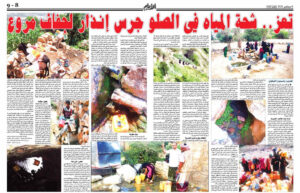Preparation-Rahma Zia
-This guide is quoted from International Journalists Network website, published on June 2023.
How can the carbon footprint be calculated? I asked this question during an advanced training course in climate journalism that I organized Ozone platform Supported by Guidance Center For emerging media initiatives of the International Journalists' Network in March 2023.
The answer requires familiarity with a number of tools that can help male and female journalists write in-depth stories about the carbon footprint of individuals and organizations.
The term “carbon footprint” refers to the amount of greenhouse gas emissions associated with a person’s activities. Emissions are measured in carbon dioxide equivalents (CO2e), which takes into account not only carbon dioxide, but also other greenhouse gases such as methane and nitrous oxide, by converting them to the emissions equivalent of carbon dioxide with the same global warming potential. United nations.
-Websites and applications for calculating carbon footprint
A number of websites and phone applications allow the use of dedicated calculators for this purpose, which translate the data entered into them into carbon dioxide equivalents. For example, you can use the free “UN Carbon Footprint Calculator” to calculate your family members’ carbon footprint annually.
You first need to collect data about the amount of consumption of family members at three levels: home, transportation, and lifestyle. Then you enter the data in the fields designated for that, and then ask the calculator to calculate your carbon footprint for you. The results show you the number of tons of carbon dioxide generated by household consumption annually, in addition to comparing it with the annual average in your country and the global average as well.
Among the data that the calculator needs to do the required task is knowing the number of family members, country of residence, area of the house, volume of monthly electricity consumption, percentage of reliance on clean energy (do you have solar panels or rely on lamps or energy-saving devices), and with regard to means of transportation, you must You determine the type of transportation used (train, subway, bicycle...) or even if you go on foot, and calculate the number of hours of use per week for all family members, and if you are riding a private car or motorcycle, you must mention the number of kilometers you travel annually. And the average number of kilometers of long trips that the family takes annually. As for lifestyle, it determines the percentage of your dependence on meat in your meals versus vegetables, and whether you buy mostly local or imported goods, in addition to the number of times you eat outside the home per week, and whether you recycle any From household waste such as paper, plastic or glass.
There are many other accounts that perform the same task, and calculators dedicated to specific purposes, such as calculating the carbon footprint resulting from various types of foods, plastics, or long trips by land, sea, and air. Among these calculators are:
Free food carbon footprint calculator
Carbon Footprint Calculator for Travel (sustainabletravel.org)
Carbon Footprint & CO2 Tracker
-Websites that provide data about the carbon footprint
There are open sources that can be used to obtain data already collected about the carbon footprint, which you can use in preparing reports, including the website environmental insights explorer Through it, you can obtain data about the carbon footprint of buildings and means of transportation annually at the level of countries and cities, and the total carbon dioxide equivalent if emissions are reduced and certain percentages are converted to clean energy.
It also provides sites such as our world in data Andstatista And other statistical data about carbon emissions in various fields such as transportation, banks, oil companies, various industries, agriculture and other fields. You can also find many facts and figures about the carbon footprint through websites. United nations AndThe World Bank AndIntergovernmental Panel on Climate Change.
How can these tools be used in stories?
These tools provide the opportunity to produce various reports on the carbon footprint of individuals and organizations, whether for awareness or accountability purposes.
It is possible to review the various sites and applications that help individuals calculate their carbon footprint in a way that contributes to spreading societal awareness, with the need to present alternatives to citizens. The United Nations presents a set of recommendations that help individuals reduce their carbon footprint during this report (Get started with these 10 actions!).
Where is it? the report To maintain a livable climate, the average must decreaseEmissions per capita per yearAbout 2 to 2.5 tons of carbon dioxide emissions equivalent by 2030. The report also provides figures about the potential reduction in emissions if the individual follows a more environmentally friendly lifestyle, such as improving energy efficiency at home, relying more on vegetables in his diet, Reducing food waste, reducing flights and other recommendations.
Low-emission options can be highlighted in press reports, such as this the report Which you posted BBC FutureAnalyzing a wealth of data on the carbon footprint of food systems, it reviews foods that are both high-protein and good for the climate, helping readers understand options that can help reduce emissions.
-We can also use Food calculator To calculate the carbon footprint of the types and quantities of foods served during major events or international conferences, and indeed some parties have begun to pay attention to providing low-emission food during the events they organize, especially related to climate change, such as what happens at the COP Conference of the Parties.
Reports can also be produced that aim to hold celebrities accountable and place them before their societal responsibility, such as this article published by Forbes magazine entitled “Leonardo DiCaprio's carbon footprint is much higher than he thinksHe drew attention to the multiple flights undertaken by the international artist (more than 20 flights in one year around the world), noting that relying on private planes for his transportation, in addition to spending vacations on yachts, caused carbon emissions much higher than average.
In another report, a newspaper L'equipe The French newspaper calculated the carbon footprint of the flights taken by football player Lionel Messi in his private plane during 3 months, amounting to 52 flights. The carbon footprint reached one and a half thousand tons of carbon dioxide, which is equivalent to what the average French citizen produces in more than 150 years, according to the newspaper. . (The English version of the original report can be read here Link).
In this type of report, which includes large numbers, it is important to use background information, visual images, and comparisons - as the French newspaper did - in a way that explains the number, gives it meaning, and presents it in a context that is understandable to the non-specialized reader.
Likewise published a newspaper The Guardian A report in which it strongly criticized the Prime Minister of the United Kingdom for using a private plane for his travels, and during its report it provided a lot of information and figures about the exorbitant bill for using private planes. The report stated that the average private plane emits two tons of carbon per hour, while the average European citizen is responsible for the emissions. It is estimated at about eight tons of carbon in an entire year.
You can obtain information and statistics about the carbon footprint of various means of transportation through the “website.”Transport and environment“.
We can produce more reports to calculate the carbon footprint resulting from long trips, whether by plane (economic or high-cost travel), by sea (yacht, cruise...) or by car, using this tool that we mentioned previously:
Carbon Footprint Calculator for Travel (sustainabletravel.org)It works by entering data about the trip (departure and arrival city, distance, type of fuel used...) and then the carbon dioxide equivalent is shown, whether for a single trip or choosing multiple trips. It also gives the equivalent amount to compensate for these emissions and the losses caused by them.
- Press reports related to the carbon footprint are not limited to holding celebrities such as football players, artists, officials, and public figures accountable, but they can also include holding institutions, companies, universities, banks, and other bodies accountable about the efforts they are taking to reduce their carbon footprint and shift to Zero carbon buildings.
Open sources and statistics sites that provide huge data on carbon dioxide emissions provide the opportunity to produce reports driven or supported by data by analyzing the data, drawing relationships between them, and making comparisons at the local and international levels. For example: the carbon footprint of transportation can be compared at the city level. Within a specific country, indicating the city with the largest share of transportation emissions, or comparing building emissions at the level of Arab countries or European countries and extracting less or more 10 countries whose buildings emit carbon emissions through the data available on the website environmental insights explorer.
Reports that display a large amount of data need an attractive visual representation, and these tools can be used, such as: Canva AndFlaticon AndFlourish Andjournaliststudio To produce attractive designs in an easy way.
Carbon footprint reports can also be produced within the framework of solutions journalism, reviewing recommendations, projects, initiatives, and research based on reducing the carbon footprint, refuting them, and discussing the possibility of their application and what hinders achieving this.
Main image from the advanced climate journalism course I organized Ozone platform Supported by Guidance Center For emerging media initiatives.





